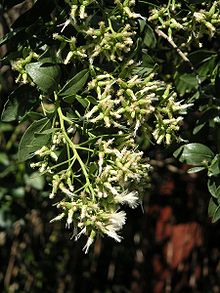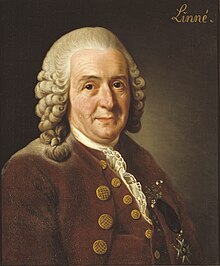Baccharis halimifolia
| Baccharis halimifolia | |
|---|---|

| |
| Scientific classification | |
| Kingdom: | Plantae |
| Clade: | Tracheophytes |
| Clade: | Angiosperms |
| Clade: | Eudicots |
| Clade: | Asterids |
| Order: | Asterales |
| Family: | Asteraceae |
| Genus: | Baccharis |
| Species: | B. halimifolia
|
| Binomial name | |
| Baccharis halimifolia | |

| |
| Natural range of Baccharis halimifolia in United States + Bahamas | |
| Synonyms[1] | |
| |
Baccharis halimifolia is a North American species of shrubs in the daisy family. It is native to Nova Scotia, the eastern and southern United States (from Massachusetts south to Florida and west to Texas and Oklahoma),[2] eastern Mexico (Nuevo León, San Luis Potosí, Tamaulipas, Veracruz, Quintana Roo),[3] the Bahamas,[4] and Cuba.[5][6][7][8][9]
Widely used common names include eastern baccharis, groundsel bush, sea myrtle, and saltbush, with consumption weed, cotton-seed tree, groundsel tree, menguilié, and silverling also used more locally. In most of its range, where no other species of the genus occur, this plant is often simply called baccharis.
Classification[]

Baccharis halimifola was first described and named by Carl Linnaeus in his Species Plantarum, published in 1753. No subspecies or varieties are recognized within the species.
This species is the northernmost member of the large Western Hemisphere genus Baccharis in the aster family (Asteraceae).
Senecio arborescens, a Neotropical species, was confused with Baccharis halimifolia in the past.[citation needed]
Description[]


Baccharis halimifolia is a fall-flowering shrub growing to about 12 ft (4 m) high and comparably wide, or occasionally a small tree. Its simple, alternate, thick, egg-shaped to rhombic leaves mostly have coarse teeth, with the uppermost leaves entire. These fall-flowering Baccharis plants are dioecious, with male and female flowers on separate individuals. Their flowers are borne in numerous small, compact heads in large leafy terminal inflorescences, with the snowy-white, cotton-like female flower-heads showy and conspicuous at a distance.[10][11]
The species is sometimes confused with the marsh-elder (Iva frutescens),[12] with which it often co-occurs, but the Baccharis has its leaves alternate, while those of the Iva are opposite.[10]
Ecology[]
Baccharis halimifolia, usually found in wetlands, is unusually salt-tolerant, and often found along salty or brackish shores of marshes and estuaries, and the inland shores of coastal barrier islands. In Florida, it is also found along ditches, in old fields, and in other disturbed areas.[11] Other habitats in the northeastern United States include freshwater tidal marshes and open woods and thickets along the seacoast.[10]
The flowers produce abundant nectar that attracts various butterflies, including the monarch (Danaus plexippus).[11] These dense shrubs also provide wildlife food and cover.[11]
Invasiveness[]

The species has become naturalized in Europe[11] and in New Zealand and considered invasive.[11]
The species features since 2016 on the list of Invasive Alien Species of Union Concern.[13] This means that import of the species and trade in the species is forbidden in the whole of the European Union.[14]
In Australia, B. halimifolia is an invasive species along the coast of southern Queensland and New South Wales.[5] As biological control the rust fungus [15] is used. Furthermore, the lepidoptera Hellinsia balanotes (Meyrick, 1908), Aristotelia ivae Busck, 1900, Lorita baccharivora Pogue, 1988 and Prochoerodes truxaliata (Guenée, 1858) were released for its biological control.
In the northeastern United States, the species has become common well inland of the shrub's natural range along various major highways where road salt is heavily used,[7] sometimes forming conspicuous displays when flowering in the fall, as along I-95 in Howard County, Maryland.
Toxicity[]
The seeds of Baccharis halimifolia are toxic to humans.[11]
Uses[]
Baccharis halimifolia is occasionally cultivated and is considered useful as a hedge or border as well as a specimen plant.[11] In southern Louisiana, it has been traditionally used as a medicine to treat inflamed kidneys and fever.[16]
References[]
- ^ The Plant List Baccharis halimifolia L.
- ^ Biota of North America Program 2014 county distribution map
- ^ Sousa Sánchez, M. & E. F. Cabrera Cano. 1983. Flora de Quintana Roo. Listados Floríst. México 2: 1–100.
- ^ USGS Geosciences and Environmental Change Science Center: Digital Representations of Tree Species Range Maps from "Atlas of United States Trees" by Elbert L. Little, Jr. (and other publications)
- ^ a b "Baccharis halimifolia". Flora of North America. Retrieved 11 October 2011.
- ^ Hitchcock, A.S. & P. C. Standley (1919). Flora of the District of Columbia and Vicinity (Contributions from the United States National Herbarium, vol.21). Washington: United States National Museum (Reprinted by Kessinger Publishing, LaVergne, Tennessee, 2010). pp. 329 (+42 plates). ISBN 1-4369-8558-7.
- ^ a b "Eastern Baccharis (Baccharis halimifolia)" (PDF). Pennsylvania Rare Plant Species. Pennsylvania Natural Heritage Program. Retrieved 28 November 2015.
- ^ "Species at Risk Conservation Fund 2009 Approved Projects". Nova Scotia Canada Department of Natural Resources. Retrieved 11 October 2011.
- ^ Heering, Wilhelm Christian August 1907. in Urban, Ignatz, Symbolae Antillanae seu Fundamenta Florae Indiae Occidentalis 5(2): 243 in Latin, mention of Cuba under var. angustior
- ^ a b c Tiner, Ralph W. Jr. (1987). A Field Guide to Coastal Wetland Plants of the Northeastern United States. Amherst [Massachusetts]: University of Massachusetts Press. ISBN 0-87023-538-9.
- ^ a b c d e f g h Brown, Steven H. & Kim Cooperrider. "Baccharis halimifolia" (PDF). University of Florida Institute of Food and Agricultural Services. Retrieved 12 October 2011.
- ^ "Iva frutescens". Flora of North America. Flora of North America. Retrieved 12 October 2011.
- ^ "List of Invasive Alien Species of Union concern".
- ^ "REGULATION (EU) No 1143/2014 of the European parliament and of the council of 22 October 2014 on the prevention and management of the introduction and spread of invasive alien species".
- ^ Jim Cullen, Mic Julien, Rachel McFadyen: Biological Control of Weeds in Australia. Csiro Publishing, 2012. Seite 91f
- ^ http://www.botanical.pbrc.edu/pdf/Brassieur%20Medicinal%20Plants.pdf
Other references[]
- Blanchan, Neltje (2002). Wild Flowers: An Aid to Knowledge of our Wild Flowers and their Insect Visitors. Project Gutenberg Literary Archive Foundation.
- Niering, William, Olmstead, Nancy, National Audubon Society Field Guide to North American Wildflowers Eastern Region, 1995, ISBN 0-394-50432-1, p. 367
External links[]
 Data related to Baccharis halimifolia at Wikispecies
Data related to Baccharis halimifolia at Wikispecies- Trees, Shrubs, and Woody Vines of North Carolina: Groundseltree, Eastern Baccharis (Baccharis halimifolia)
| Wikimedia Commons has media related to Baccharis halimifolia. |
- Baccharis
- Flora of North America
- Plants described in 1753
- Taxa named by Carl Linnaeus
- Medicinal plants of North America